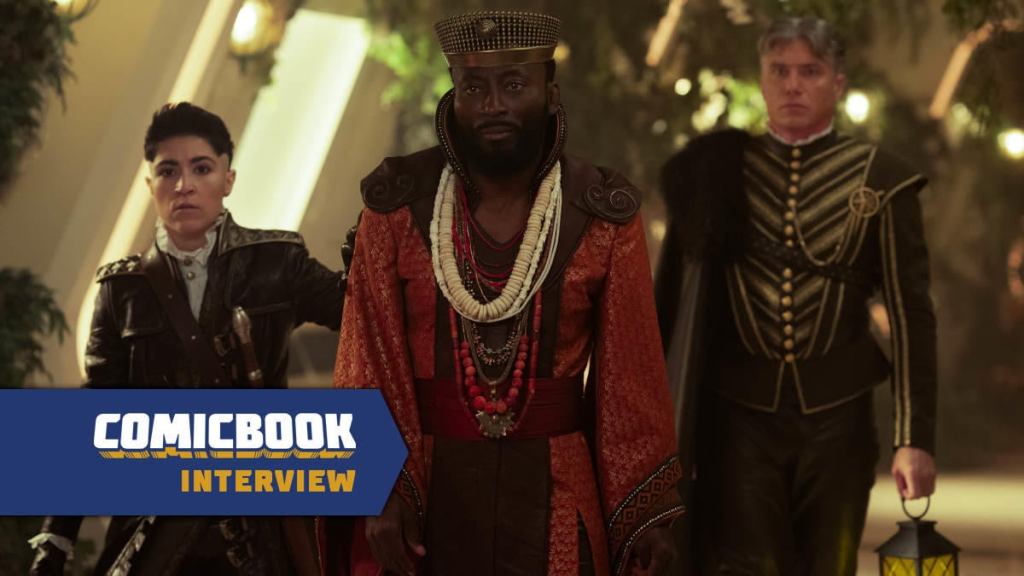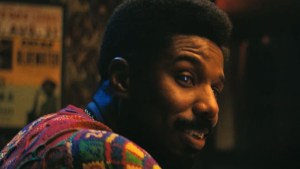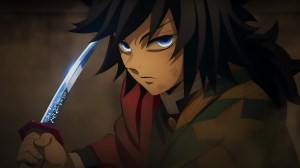“Nostalgia” is the watchword that guides the outfitting of Paramount+‘s Star Trek; Strange New Worlds, according to costume designer Bernadette Croft. Having previously been an assistant to Star Trek: Discovery costume designer Gersha Phillips, Croft moved on to Star Trek: Strange New Worlds when work on the spinoff series began. Now in its second season, Star Trek: Strange New Worlds is a prequel to Star Trek: The Original Series. As Croft tells ComicBook.com in an interview via video call, much of her work on the Star Trek streaming series is about modernizing the look of the original 1960s series, whether that developing Star Trek: Strange New Worlds’ classy but casual iteration of the Starfleet uniform and bringing the Klingons back closer to their original sense of fashion.
Videos by ComicBook.com
“Leaning into the nostalgia, elevating some of those original ideas that the costume designer at the time, William Ware Theiss, had, updating the fabrics, the technologies that we use, the processes, and leaning into color a little bit more, the vibrancy,” Croft says of her work. “Other shows are a little darker, a little more monochromatic in terms of the grayscale and you can’t really see what’s going on sometimes. But on Strange New Worlds, it is just a little bit more powerful because you can see all that color and that vibrancy.
During our conversation, Croft touched on her approach to the Klingons, bringing , why the show brought back the green tunic that appeared seemingly at random in Star Trek: The Original Series, and why the fairytale-like “The Elysian Kingdom” is being submitted for Emmy Awards consideration. Here’s what she had to say:
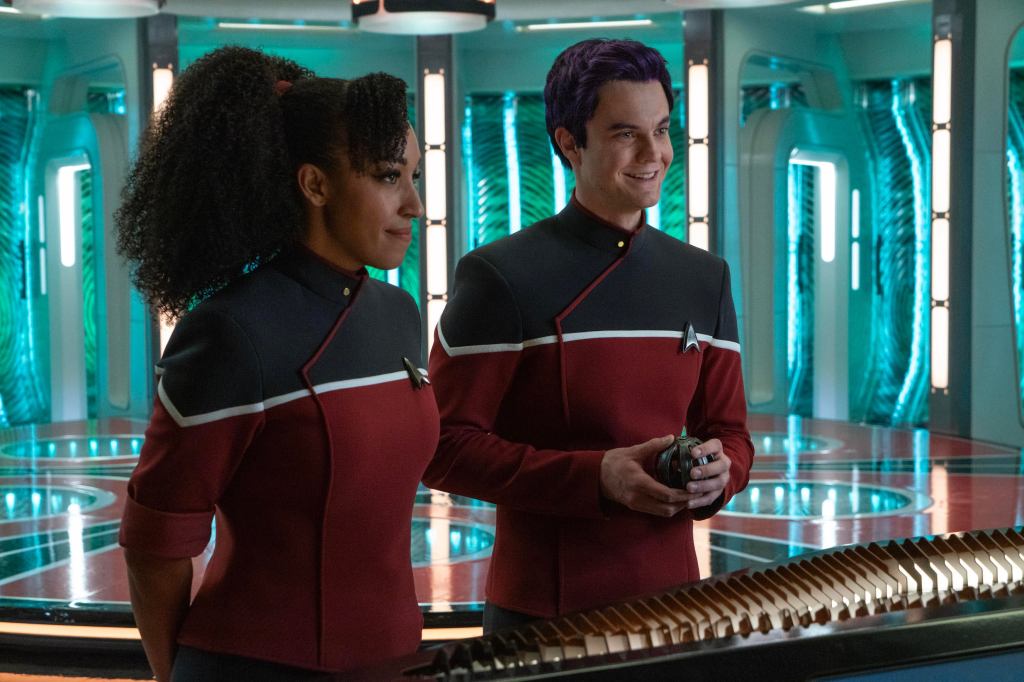
Star Trek: Strange New Worlds is a prequel to Star Trek: The Original Series. How familiar were you with that series before starting to work on Star Trek yourself? Were you a fan? Did you have to do some homework or did you immediately have ideas about how things should look?
Bernadette Croft: No, I definitely had to do my homework. I didn’t grow up watching it. My mom did. She loved it, but I wasn’t really introduced to Trek until I worked with Gersha Phillips on Discovery. I was her assistant costume designer, and I, later on, co-designed a couple of episodes with her. So I’ll have to thank her for opening me up into this magical world because since then I’ve like devoured most of Star Trek and I just love it, especially Lower Decks. That’s my favorite Star Trek show. I’m glad that I found that later in life.
Since you mentioned Lower Decks, were you the one responsible for translating those beautiful animated costumes into the beautiful live-action costumes that we see in the Star Trek: Strange New Worlds Season 2 trailer? What challenges were there in adding a dimension, literally, to that look?
We’re essentially inspired by animation, these tiny little figures, and we have to transport that idea to human people. Tawny Newsome and Jack Quaid are both quite tall humans — Jack Quaid’s like 6’3′, 6’4″, or something like that — so we had to make sure we honor the animation, but also for it to make sense in our Strange New Worlds visual landscape.
The fabric is actually the same as our Strange New Worlds uniforms, we just backed it with neoprene to make it a little bit more buoyant. It floated off the body a little bit, and it’s very, very smooth. We didn’t add any microprint because our series creator was just like, “Let’s just leave that out. Let’s just make it really simple.” So we honored them there and didn’t add any microprint like we do on our Strange New Worlds uniforms.
We just had to really look at the details: the Lower Decks have an emblem on the sole of their boot, Mariner kind of folds her uniform three-quarters of the way up, and little things like that — she’s kind of a bit more nonchalant, she’s got that scrunchy in her hair — there were all these little details that we had to really pay attention to.
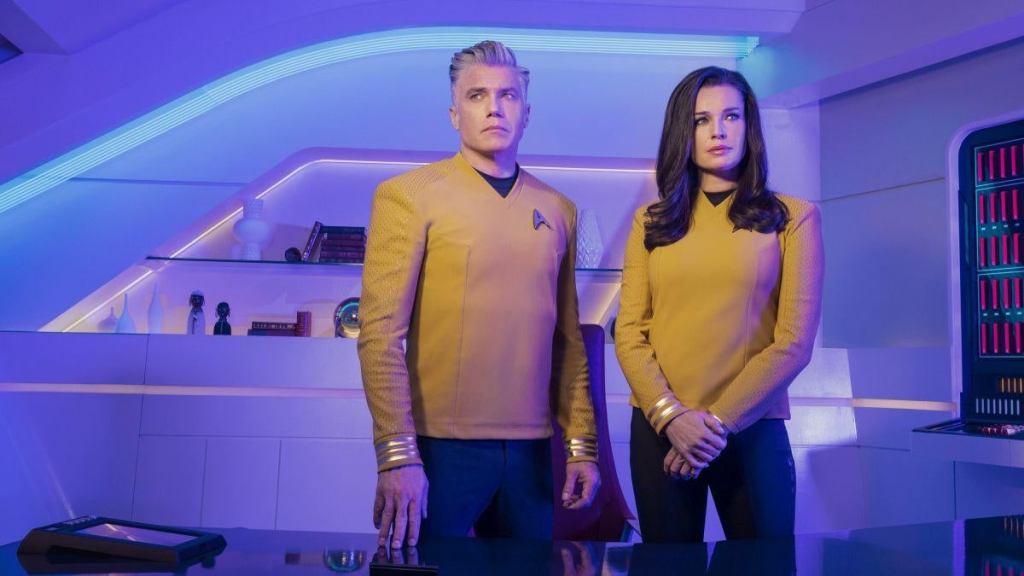
Speaking of Starfleet uniforms. What was the mission brief when it came to the uniforms we see in Star Trek: Strange New Worlds and the changes made from the Enterprise uniforms we saw in Star Trek: Discovery to something that looks more like the uniforms in Star Trek; The Original Series? What was the idea there, and were there any particular challenges, or problems you had to fix as you went?
The biggest issue was that we were developing these costumes during COVID, so a lot of our manufacturers were closed. It was really hard to get materials. Whenever we ordered something online, it came sometimes, and then sometimes it just didn’t, it didn’t show up. But luckily, Gersha was working on Discovery at the time, so we actually borrowed a lot of fabrics from her, like trims, zippers, thread, all of the basic things that we needed to get our costume shop off the ground.
But in terms of the design, we knew it was going to be important. We knew Strange New Worlds had to lean into the nostalgia of the original series, but still elevate it for today’s audiences. And I think today’s audiences, they expect a certain level of production value, and we wanted to pay tribute also to what Gersha has done on Discovery with that more of a heroic silhouette. It’s a little bit more formal, but we also wanted to make it casual. So linking those two shows together, that was a bit of a challenge.
I think, in the end, we offered up 30 options to our showrunners and they essentially chose what we see on our screens today, and I think they made a great choice. I think it’s still simple, it’s classic, it’s casual, it’s still colorful, but we’ve got the detail, like the micro-print, the silhouette’s really strong, and the actors have said that it’s comfortable. So we’ve got that on our side as well.
Is the COVID-19 pandemic part of why you turned to 3D printing for certain pieces? I know you sued it for some of the crowns and jewelry in “The Elysian Kingdom.” Or was there more to it than that?
We want everything to be unique, memorable. We want to add that production value. So certain detail we often have to hand sculpt, but with 3D printing it’s much faster. When you don’t have a lot of prep time for episodes — for us it’s like two weeks — we need to make sure we infuse these episodes with as much detail, as much production value. So often 3D printing is the way to go, and it really is essential for us to keep on budget, to keep within the timeframe, but also to infuse that detail to ground the costumes in something that seems realistic, I would say.
What was your reaction when you first saw the script for “The Elysian Kingdom”? Were you surprised by suddenly having to craft all of these fairytale looks for this sci-fi show?
No, I literally thought it was a dream come true. I love fantasy. I was a fantasy kid, more so than sci-fi as a kid, so I thought they were delivering us gold. I was like, “Thank you very much for this costume episode.” The costumes are so vivid, they’re whimsical, they’re eclectic. I designed the episode through the eyes of Rukiya, who’s the 10-year-old girl in the episode, and I think kids just have such a vivid imagination, and they don’t think genre, they don’t think a specific time period, they just think whatever is fantastic. So that was my design brief, just design fantastic costumes that could be in this fantasy world in space. So I was really thankful to Onitra Johnson and Akela Cooper for that wonderful script. And it happens again in Season 2. We’ve got some really amazing episodes that are costume-heavy, which we always love. Not every episode is like that, obviously, but we really love it when we can really show what we can do.
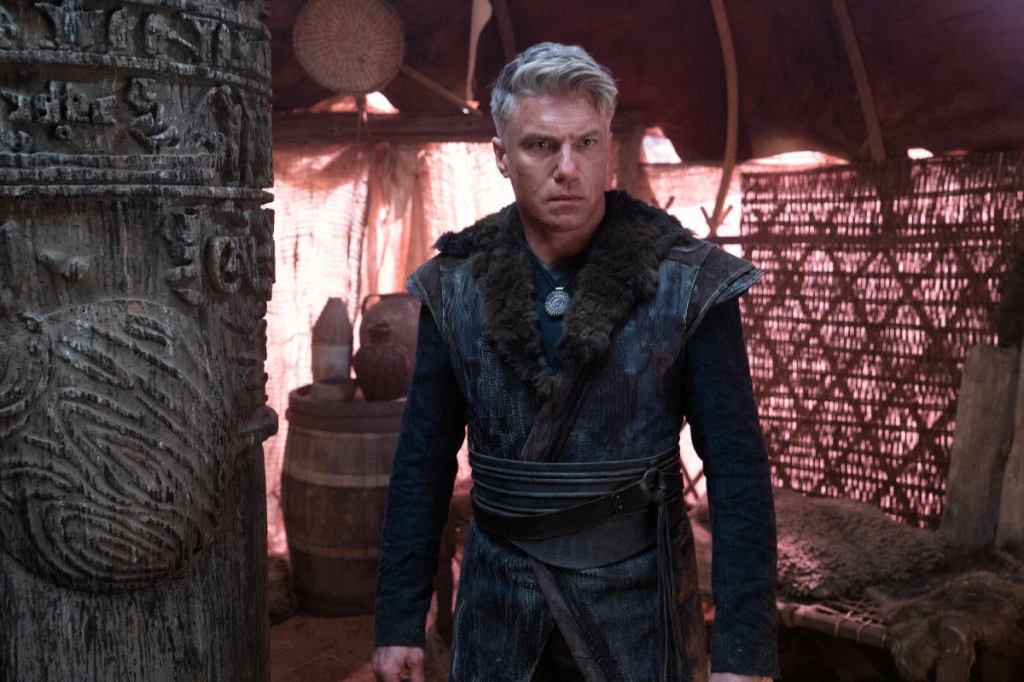
I was going to ask about that. So then Star Trek: Strange New Worlds Season 2 is going to give us another episode on that same level, costume-wise, as “The Elysian Kingdom”?
Yeah. I think the most extreme would probably be the Rigel VII costumes. That was an episode where the team, they’re in disguises, they have to go to Rigel VII to this planet. We can tell by what they’re wearing that the planet’s got maybe extreme weather conditions. We can tell that it’s kind of a bit of a medieval look. And when they land, they’re expected to work under these conditions, and so their costumes emulate those conditions. So they’re rough around the edges. The fabric’s weathered, it’s worn, it’s broken down. The mud on the boots, you can see all that. So it’s lots of detail that we wanted to infuse there. The guards’ costumes were influenced by ancient Mongolian armor. It was an eclectic moment where we could bring a few elements together for this world, for Rigel VII.
Even Episode 1 was really fun. Those rebel Klingons in that down-and-dirty, gritty flea market scene, all of those kinds of costumes were fun to do as well. There are a few ones coming up. The crossover episode’s really fun. And there’s another one I can’t really say, but yeah, you’ll come to it.
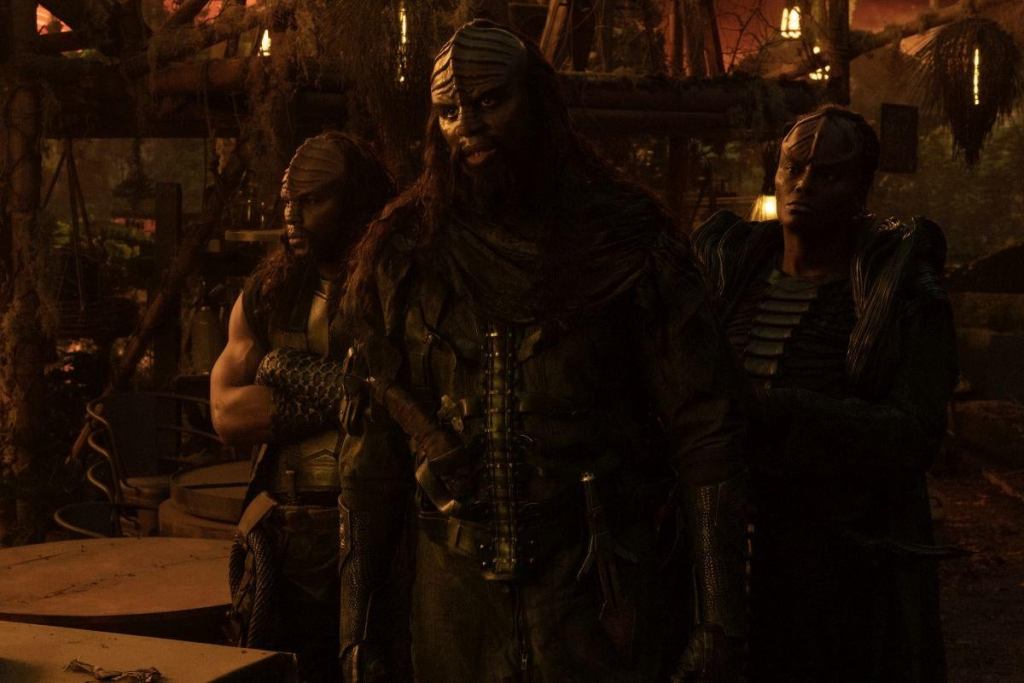
You mentioned the Klingons. They look much closer to how they appeared in Star Trek: The Original Series here than they did when they appeared in Star Trek: Discovery. What was the approach there?
It came from our showrunners, Akiva Goldsman and Henry Alonso Myers. They wanted me to lean into the nostalgic TOS but elevate it. The Klingons were a real highlight. They’re such an infamous and beloved alien, and in The Original Series, the costumes were these stretchy black and gold that looked like dance costumes. The belt buckle was bubble wrapped, and it was just painted. That was okay for the time, but I couldn’t do that for today’s audiences, there’s no way. I had to elevate it to infuse more details. So what I did was I used the original palette, so the black and the gold, the original square neckline, but I made it more like a hard armor with this exoskeleton detail over the top that was hand sculpted by our sculptor, Alex Silberberg, and I think it makes them look a little bit more intimidating. It’s just a little bit more memorable to TOS rather than Discovery.
It’s clear that storytelling is baked into your design work, such as you infused the Rigel VII costumes with a bit of worldbuilding, and created the look of “The Elysian Kingdom” from a specific character’s perspective. Was that part of what drew you to this kind of design work? Or was that something you had to learn as you were working on these kinds of series?
Going into it, we were definitely told it was re-imagining, that we could bring elements from the past but still make it our own. I’ve been really lucky enough that our showrunners are so open to ideas. It’s not as if no idea is passed away. Everything’s carefully considered. It’s been just a wonderful journey, and I think Gene Roddenberry’s original vision for the show was to inspire, uplift, make you think, and ultimately leave you with this optimistic view. So for me to work on a show that’s positive, and it’s this amazing legacy, it’s just such an honor. So yeah, I jumped at the chance to be able to contribute to it visually.
I thought it was fun that you also brought back that green wraparound uniform Captain Kirk sometimes wore on Star Trek: The Original. It was a completely unnecessary thing to do, but I think fans really appreciated seeing it. Did you all talk about the purpose of that uniform and why it should show up in Star Trek: Strange New Worlds?
Akiva really wanted us to pepper that green wrap jacket somewhere in the show. It was just one of those things that I think tickled his fancy. It’s just like, that’s a funny thing that they did. Why not? Let us do that too. So I did some research, and it’s hard to decipher why they did that. One idea was that William Shatner kind of just changed shape over time, so it was to hide his physique a little bit more, but we don’t really know, so we just did our Strange New Worlds version of it. We made the shoulders a little stronger. The fabric wasn’t as Kermit the Frog green, it was just a little bit more olive, and we just did our version of it. And it’s funny, in TOS, there are several of the green wrap jackets, so we might be doing several of them too as seasons go on. We don’t know, we might do that.
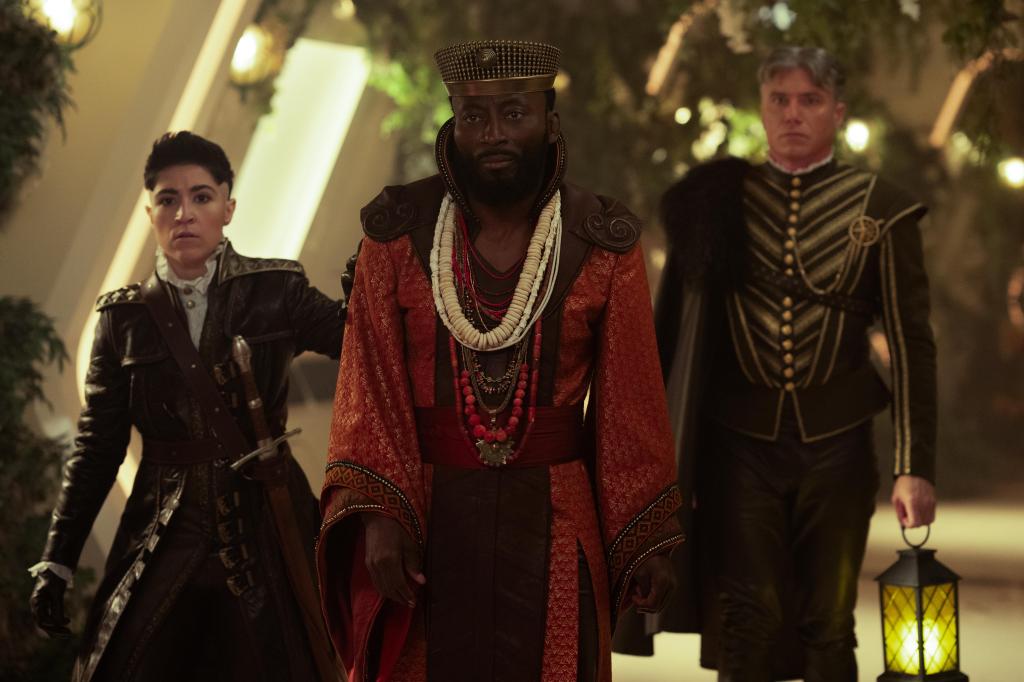
“The Elysian Kingdom” is the episode that’s been submitted for Emmy consideration. Why that episode? Is it simply the episode where you and your team got to flex your skills the most?
Well, interestingly, this episode wasn’t eligible this last year’s Emmys because of the way our series was delivered. Only the first seven, I believe, episodes were up for Emmy consideration last year. So this year my favorite episode happens to be eligible, so it’s a no-brainer for sure. I think it encapsulates all of what Star Trek stands for, and for me, technically, it showcases the skill and talent of my team.
We handcrafted every single thing on the costumes, or 3D printed it. Even the Crimson Guards, the armor, there’s like 150 leather pieces that are constructed by Jennifer Johnson, our key effects builder. It’s just amazing what the team could do, considering we didn’t have a lot of time, and I loved how they really rose to the occasion at this moment. It is just that warm, fuzzy feeling of nostalgia. It reminds you of a kid. It’s really vivid. It’s whimsical. It gives you that optimistic view of the future in a way. I was really happy that there was a chance to have it up for consideration at least.
Star Trek: Strange New Worlds, being more episodic than Star Trek: Discovery or Star Trek: Picard, brings new elements in with almost every episode. With all of that, is there a guiding theme that you follow to keep the show looking cohesive and make sure all of those aliens of the week or whatever else still feel like they fit into the world of the show?
I would say “nostalgia,” for sure. Leaning into the nostalgia, elevating some of those original ideas that the costume designer at the time, William Ware Theiss, had, updating the fabrics, the technologies that we use, the processes, and leaning into color a little bit more, the vibrancy. Other shows are a little darker, a little more monochromatic in terms of the grayscale and you can’t really see what’s going on sometimes. But on Strange New Worlds, it is just a little bit more powerful because you can see all that color and that vibrancy. So I would say nostalgia is that North Star for us.

Has there been an instance where the nostalgia became too much and you had to pivot or to something different? Maybe on a previous interaction of the uniform, or some other situation where that fondness for the classic look became a stumbling block?
There wasn’t really a stumbling block, it’s just making sure things look cohesive and professional. The miniskirts, for instance, that was a moment where when Gersha and I were first discussing the costume, maybe we shouldn’t do that because they were really wonderful at the time and a real showstopper, but it doesn’t really resonate in today’s society, and it can be seen as sexist. So we were thinking maybe not the miniskirts. But then Rebecca Romijn showed us this other way of thinking, which is you can still be professional, you just maybe have to tweak it somehow. So we just put leggings under the little tunics that we do. We’ve made it unisex so any gender can wear the uniform.
I would say little moments like that where certain things happen in the ’60s that should maybe stay in the ’60s. We’ll just pivot, as you say, to something that resonates with today’s more mature audiences who expect story, they expect character, and they’re very smart. They’re not going to see the gimmicks and just think, “Oh, I’m being played here.” They expect more from storytelling.
On the flip side of the nostalgia, has there been any particular alien species in Star Trek that’s been especially fun to work on? Or maybe the flipside of that, where there’s one that’s been particularly challenging?
I think whenever there’s a legacy alien, you have to look at all the different iterations of the alien. We have meetings about the alien, how prosthetics are going to do their work, hair and makeup, costumes, and what the props department going to do. We all want to be on the same page. So legacy aliens do require a lot more consideration. When aliens are new to this series or to canon it’s that spark of excitement. You can think of anything here. We’re establishing something that may have to be redesigned in other Star Trek shows to come. You never know. So a real highlight for me from Season 1 was the Deleb aliens. They’re in Season 2, and they weren’t featured highly, but I think they were so intricate and beautiful.
They were a desert-dwelling, alien race, so I leaned into inspirations from nature, organic rock formations, the veins of a leaf, or a very natural palette, and looked at fashion designers like Iris van Herpen and the way that she does folds and pleating, and all of her kind of work is very alien in a way. It was really a wonderful alien to bring together, and our textiles team, headed by key technical artist Anna Pantcheva, did such a wonderful job. She did ice dying and bleach dying. She covered things with silicon, embroidered in a very organic way to make them look alien. So yeah, very proud of those aliens.
How to watch Star Trek: Strange New Worlds Season 2
Star Trek: Strange New Worlds Season 2 debuts new episodes on Thursdays on Paramount+ in the United States, the U.K., Australia, Latin America, Brazil, France, Italy, Germany, Switzerland, and Austria. The second season will stream on Paramount+ in South Korea, with a premiere date still to be announced. Star Trek: Strange New Worlds airs on Bell Media’s CTV Sci-Fi Channel and streams on Crave in Canada and SkyShowtime in the Nordics, the Netherlands, Spain, Portugal, and Central and Eastern Europe.
Star Trek: Strange New Worlds Season 1 is also streaming on Paramount+. It is also available as home media on Blu-ray, DVD, and 4k UHD.

